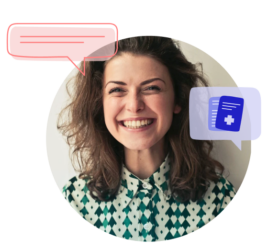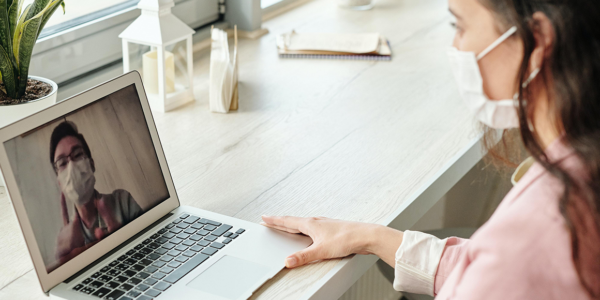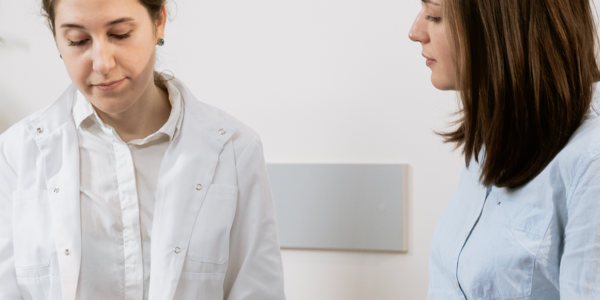Practicing empathy, especially through a screen, can be difficult. Nuances of in-person communication can get lost when communicating asynchronously. That’s why it is so important to always be asking yourself how to show empathy over text more effectively.
Let’s begin by deciding on a definition for empathy. In the context of healthcare, empathy is generally defined as the ability to understand a situation and show compassion for the feelings associated with that experience. Although this may seem simple, it is important to remember that being empathetic is a conscious choice. Empathy, especially through text, takes effort. Even more, being empathetic to others when you’re stressed and seeking empathy for yourself, is really difficult.
But nonetheless it is incredibly important to the success of your patients. In fact, one of the most widespread complaints from patients is that their physicians don’t listen adequately.

Be there for your patients
Show you care by making it easy for patients to communicate securely with your care team. See how HIPAA compliant texting can work for your practice.
Benefits of learning how to show empathy to patients and families
There are countless benefits of showing empathy to your patients over text. Empathetic communication can result in better provider-patient relationships and improve patient satisfaction. Studies have shown that empathy in clinician/patient engagements also increases adherence to medication and decreases malpractice claims.
When it comes to families and caregivers, empathy is just as crucial. If you are able to be empathetic to the concerns of family members, you’re able to decrease their distress and emotional intensity.
OhMD’s guide to showing empathy over text
This above data makes it clear just how important empathy is in healthcare. But conveying empathy over text can be a bit more difficult than in person. That’s why we have compiled the following guide for your convenience.
Make sure your patients feel heard, acknowledged, and validated
This one may feel a bit obvious, but it’s easier said than done, especially via text. Here are some suggestions for language to use to achieve this outcome:
- “I’m here for you.”
- “What do you need right now?”
- “I’m happy to listen any time.”
- “I’m sorry you are going through this.”
- “That sounds really challenging.”
- “I can see how that would be difficult.”
Using empathetic, compassionate statements like those listed above, you are able to address the experiences of your patients without diminishing the effects they may have had.
Show interest in your patients
Again, this may feel like a given. But often in the rush of work and life we forget to show a genuine interest in others, and this can be especially difficult over text message conversations. Remember, all areas of life, especially social relationships, have an effect on our health. If you, as a provider, are able to show an interest in other areas of your patients’ lives, it’s likely that they will have better health outcomes and increased trust in your skills.
Here are some examples of how to dive deeper when communicating with patients over text:
- “How are you feeling about everything?”
- “What I’m hearing is that you are feeling _______. Is that right?”
Questions like these allow you to convey interest in the overall wellbeing of your patients- which is essential. Active listening is key to getting patients to open up and feel comfortable sharing their concerns with you, knowing they will be met with sympathy and support.
Demonstrate gratitude
Most people don’t like talking about their feelings. This doesn’t mean that you shouldn’t try to dive deeper when it’s clear that a patient needs someone to talk to. You do, however, need to remember to acknowledge the fact that they opened up to you and you are grateful for that. This could come in many forms, but here are a couple of examples to start with:
- “Thank you for sharing with me.”
- “I’m glad you told me.”
- “This must be hard to talk about. Thanks for opening up to me.”
Use open-ended questions
In general, open-ended questions are the way to go when it comes to building empathy with patients over text. Closed-ended questions (those that only require a ‘Yes’ or ‘No’ response) definitely have their place in communication. You don’t need to ask an open-ended question when you are trying to evaluate whether a patient took a medication, for example. But in other cases, an open-ended question could come in handy.
Maybe you are trying to determine whether a patient needs to go to the hospital for a pain they are having in their stomach. Asking them whether they have pain (a closed-ended question), wouldn’t be helpful. Rather, you’d want them to explain what the pain feels like and where it is originating (an open-ended question).
If you are able to use closed-ended questions only when necessary, and otherwise lean towards open-ended questions, you are likely to get more valuable information from your patients. Open-ended questions are critical when using asynchronous messaging. This is because of the potential time delay between messages being sent and received. This makes asking the right open-ended questions essential as they allow you to gather more information at one time.
Use texting to follow-up
Lastly, you can use texting as a way to follow-up with your patients. This could mean re-evaluating symptoms, asking them if they’re taking their medications as prescribed, or just checking in. Whatever you choose, texting is a great option to reach your patients after their appointment has ended.
Make empathy easy
In the midst of the above recommendations, we also recognize that healthcare providers are busy, stressed, and usually pressed for time. For that reason, we recommend making your most common messages into a template. Our Saved Replies tool allows you to easily find and manage your frequently-used messages.
As we noted earlier, empathy isn’t always quick or easy to convey, especially through a screen. That’s why we recommend identifying your favorite empathetic messages and holding onto them for easy access. Patient communication solutions like OhMD makes this easy by allowing you to create message libraries as Saved Replies. This will encourage all staff members to be empathetic in an efficient way.
Empathy throughout the patient experience
General patient questions
You never know when patients may have a question regarding their health. That’s why texting is a great solution. You can answer questions asynchronously, when it is convenient to you. During these conversations, patients may show a need for extra support from their providers. Here are some ways to respond to their concerns that impart empathy:
- “Great question, I’m glad you reached out!”
- “I understand how that can be worrisome. We’d love to get you into the office so we could take a look.”
Each of these messages show that you hear the patient concern, you care, and you are taking their situation seriously. They are also quick and easy ways to validate the patient’s experience, which builds up their trust in you as their provider.
Pre-visit
When preparing for a visit, you will likely be reaching out to a patient to remind them of their upcoming appointment. Including a touch of empathy in those reminder messages makes it clear to the patient that you and your care team are fully in their corner and willing to accommodate to their changing needs. Here is an example of how to use empathy in a reminder Broadcast message.
“Hi {patient name}! This is {practice name} reminding you of your upcoming appointment on {appt date} at {appt time}. We understand that life happens, so if you are unable to make it to your appointment, just let us know. We’d be happy to find a time to get you seen that works best for you.”
Adding those two quick sentences at the end of your message reminds the patient that they are always your first priority.
Post-visit
Following a visit, it’s a great idea to remind patients that your text line is always at their disposal. Of course, it should not be the first line of contact in an emergency, but for general questions or concerns, it is always a good place to start. One way to remind patients of this option is to send them a follow-up message after their appointment. This could include any of the following language:
- “Hi {patient name}! This is just a reminder that you are welcome to message this textable number with any questions or concerns that may arise following your recent appointment.”
- “Thanks for making time for your recent appointment. If you ever have anything come up that you’d like us to be aware of, don’t hesitate to write in to this textable office number.”
Although it may seem unnecessary to remind your patients that they can easily connect with you via text, it makes a major difference in their experience. They will feel better cared for and will therefore be more likely to remain patients at your practice.
How to show empathy over text in your role
Front Desk, Administrators, and Patient Access Representatives
Medical administrators are truly the first line of defense in the office. Showing empathy to patients is absolutely critical in all of the above roles. Although the patient is not there to see you as a provider, they will undoubtedly remember you from text conversations. The role of anyone with access to patients is to act as a liaison to the provider. Showing that you care and putting patients at ease is integral to your role.
Providers
It wouldn’t be a reach to suggest that many patients have had a mixed bag of positive and negative experiences when it comes to healthcare. Fear, anxiety, pain, and discomfort are all possible associations with seeking healthcare. That means that, as a provider, understanding and embracing the role of technology in communication with patients is very important to help alleviate their possible feelings of apprehension.
Many providers have spent years honing and improving their bedside manner. But with new technology, they are also forced to improve their webside manner. Over text, traditional ways of conveying empathy, like eye contact, are no longer possible. Taking what you know about a patient from your in-person interactions and applying that knowledge to asynchronous communication goes a long way.
Billing Specialists
No one is excited about paying bills. Finances are generally a touchy subject and are variable patient-to-patient. Understanding this and treating patients over text the same way you would face-to-face is imperative. In person, body language and facial expression allows you to understand how someone is feeling. Social cues like body language don’t exist over text. That means that being upfront about expectations and options for payment is both important and allows you to be empathetic even in uncomfortable situations.
Effectively communicating empathy, even in person, can be difficult. Show empathy over text or other asynchronous communication tools can be even more difficult. This said, armed with some tips and templates to pull from we hope your future patient interactions can help you build trust and long-term relationships that are mutually beneficial for you and those you care for.
See how simple patient communication can be with two weeks of free HIPAA compliant texting and all the other OhMD tools!

End missed patient calls. Start texting!
Texts get read 99% of the time, while calls from an unknown number get answered only 20% of the time. See why over 50,000 providers choose OhMD to actually connect with their patients.




